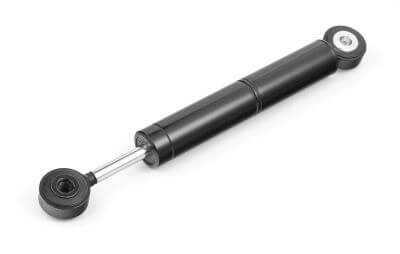What Is an Oil Damper?
 An oil damper is a device that uses the viscosity of oil to absorb vibration and shock. An oil damper contains oil and a piston. The piston has a small valve, and when the piston moves due to vibration, the oil moves through this valve.
An oil damper is a device that uses the viscosity of oil to absorb vibration and shock. An oil damper contains oil and a piston. The piston has a small valve, and when the piston moves due to vibration, the oil moves through this valve.
The viscous resistance through the valve converts the vibration energy into thermal energy, thereby suppressing vibration. Oil dampers are used for vibration isolation and control in buildings, and for vibration and shock absorption in automobiles and other vehicles.
Uses of Oil Dampers
Oil dampers are used for earthquake resistance in buildings and for general vibration and shock control. The most common architectural application is earthquake protection for high-rise buildings and general buildings. Oil dampers are used in seismic isolation structures, which separate the building from the ground to prevent seismic shaking from being transmitted to the building, and in vibration control structures, which absorb shaking in the event of an earthquake.
In high-rise buildings, swaying of the upper floors, especially due to long-period vibrations, can affect the human body and cause objects in the interior to fall or break. For this reason, seismic isolation and vibration control structures are used. Small vibration dampers are also used in buildings such as houses and offices at the connections between components.
Oil dampers are also used in seismic devices for piping and boilers in power plants and plants. Nuclear power plants, in particular, require a high level of safety, and the latest damper devices are used.
In automobiles and other vehicles, oil dampers are incorporated into the suspension system. They are also called shock absorbers. It is an important component that determines driving stability and ride comfort. Most are installed in the center of a coil spring, and the damper dampens and converges the vibration of the spring.
Principle of Oil Dampers
An oil damper consists of a cylinder containing a piston, rod, and oil. The piston has a small-diameter valve, and vibration causes the oil on both sides of the piston to move repeatedly through the valve.
As the viscous oil moves back and forth through the valves, the kinetic energy of the vibration is converted into thermal energy, thereby reducing vibration. There are many types of oil dampers, including bi-flow and uniflow types for construction and industrial applications, and automotive applications.
1. Bi-flow Type
This is a system in which the direction of oil flow in the cylinder changes when the oil damper is extended or retracted. Two check valves are used for the piston valves, and the piston rods are attached to both sides of the piston in order to equalize the volume on both sides of the piston. This type has no restrictions on the mounting angle and is used in dampers.
2. Uniflow Type
This is a method in which the direction of oil flow in the cylinder does not change when the oil damper is extended or retracted, making the configuration a little more complicated. The cylinder is doubled and combined with both sides of the piston to form three chambers.
Each chamber is connected by a one-way valve, and oil flows in only one direction. The piston rod only needs to be in one direction, thus reducing the overall size. Since the outer chamber has an air layer, it must be used horizontally and is used for seismic isolation of buildings.
3. For Automobiles
Automotive oil dampers are also available in mono-tube and twin-tube types, and can be used in the vertical direction. When the back side of the piston is under negative pressure, the oil foams, so nitrogen gas is filled to increase the pressure. The mono-tube type has the advantage of a larger piston diameter, but has the disadvantage of a longer overall length due to the coaxial arrangement of the gas chamber. The twin-tube type is the mainstream for general automobile suspensions.
Other Information on Oil Dampers
1. Oil Damper for Seismic Isolation
Seismic isolation structure separates the building from the ground so that seismic shaking is not transmitted to the building. Uniflow type oil dampers are installed horizontally between the ground and the building. In addition to the oil damper, isolators such as high-damping laminated rubber are used to support the building.
When an earthquake occurs, the seismic energy input to the building is absorbed by the oil damper, reducing the shaking of the building. Compared to vibration control structures, the intensity of shaking is greatly reduced, which not only prevents damage to the building but also allows the building to maintain its functionality after an earthquake.
2. Oil Damper for Vibration Control
A vibration control structure is a device designed to absorb the shaking caused by an earthquake. Bi-flow oil dampers for vibration control are attached directly to walls and columns to absorb the energy of seismic shaking. In high-rise buildings and condominiums, they are installed on each floor to reduce the swaying of high-rise floors that are prone to swaying. Often installed diagonally like a brace, they are designed to handle vertical as well as horizontal shaking.
Because it is a compact device, this method requires only a few missing points in the insulation material and has a small effect on insulation performance. For this reason, installation in ordinary houses, such as wooden houses, is also being promoted.